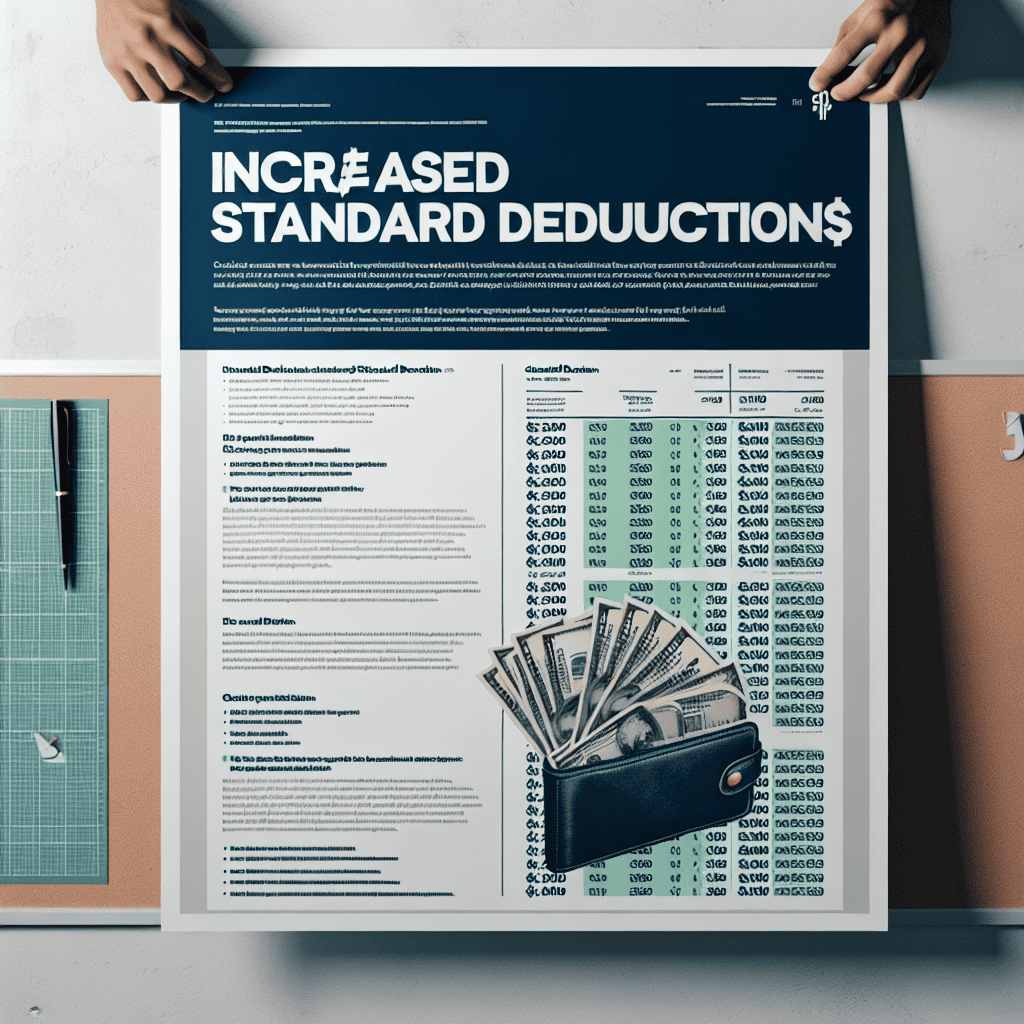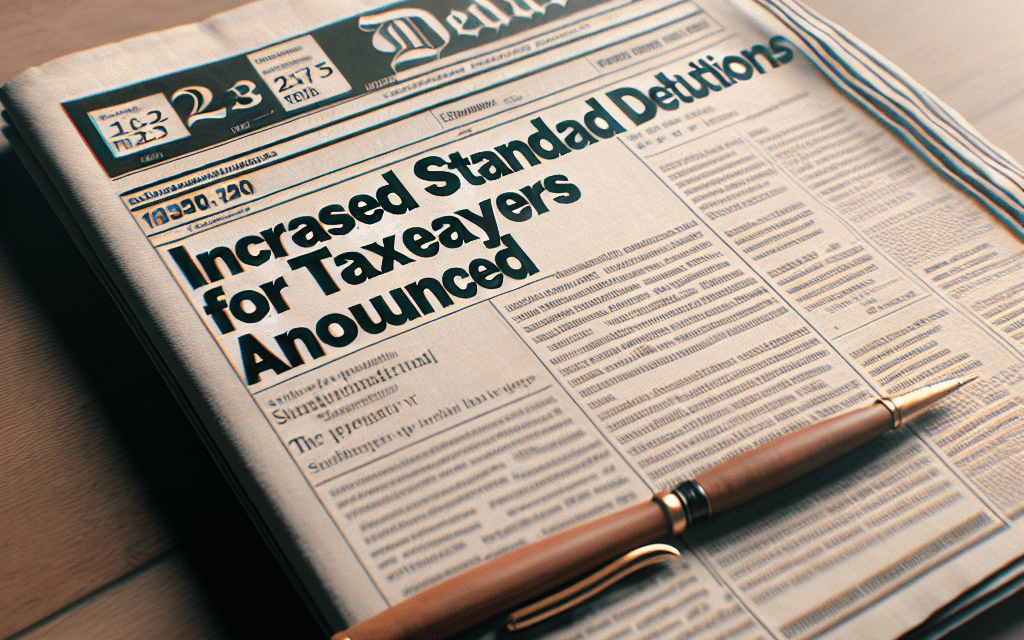“Boost Your Savings: IRS Raises Standard Deductions for 2025!”
Introduction
In 2025, the Internal Revenue Service (IRS) has announced an increase in the standard deduction amounts for taxpayers, reflecting adjustments for inflation and changes in tax policy. This adjustment is part of the IRS’s annual review to ensure that tax provisions remain aligned with economic conditions, providing taxpayers with potential relief and simplifying the filing process. The increased standard deductions are designed to reduce taxable income for individuals and families, potentially lowering their overall tax liability and making it easier for many to file without itemizing deductions. This change is expected to impact a broad range of taxpayers, offering them greater financial flexibility and contributing to a more streamlined tax filing experience.
Understanding the 2025 IRS Standard Deduction Increase
In a significant development for taxpayers across the United States, the Internal Revenue Service (IRS) has announced an increase in the standard deduction for the tax year 2025. This adjustment, which reflects the IRS’s ongoing efforts to account for inflation and the evolving economic landscape, is poised to impact millions of taxpayers, offering potential relief and simplifying the tax filing process for many. As taxpayers begin to plan for the upcoming tax season, understanding the implications of this increase is crucial for effective financial planning and compliance.
The standard deduction is a critical component of the U.S. tax system, allowing taxpayers to reduce their taxable income without itemizing deductions. For 2025, the IRS has raised the standard deduction to $15,000 for single filers and $30,000 for married couples filing jointly. This increase represents a notable rise from the 2024 levels, which were set at $13,850 for single filers and $27,700 for joint filers. The adjustment is part of the IRS’s annual review process, which considers inflationary pressures and aims to ensure that taxpayers are not unduly burdened by rising costs of living.
One of the primary benefits of the increased standard deduction is the potential for tax savings. By raising the threshold, the IRS effectively reduces the amount of income subject to taxation, which can lead to lower tax bills for many individuals and families. This is particularly beneficial for those who do not have enough deductions to itemize, as it simplifies the filing process and provides a straightforward way to reduce taxable income. Moreover, the increase may also encourage more taxpayers to opt for the standard deduction, thereby streamlining the overall tax filing process and reducing the administrative burden on both taxpayers and the IRS.
In addition to the immediate financial benefits, the increased standard deduction also reflects broader economic trends and policy considerations. As inflation continues to affect the purchasing power of consumers, the IRS’s decision to adjust the standard deduction is a recognition of the need to align tax policy with economic realities. This move is consistent with the agency’s mandate to ensure that the tax code remains fair and equitable, providing relief to taxpayers in a manner that reflects current economic conditions.
Furthermore, the increase in the standard deduction may have implications for tax planning strategies. Taxpayers who have traditionally itemized deductions may find that the higher standard deduction offers a more advantageous option, prompting a reevaluation of their tax strategies. Financial advisors and tax professionals are likely to play a key role in helping individuals navigate these changes, offering guidance on how to optimize tax outcomes in light of the new deduction levels.
As taxpayers prepare for the 2025 tax season, it is essential to stay informed about these changes and consider their potential impact on personal finances. The IRS’s announcement underscores the importance of proactive tax planning and the need to adapt to evolving tax policies. By understanding the increased standard deduction and its implications, taxpayers can make informed decisions that align with their financial goals and ensure compliance with tax regulations. In conclusion, the IRS’s decision to increase the standard deduction for 2025 represents a significant development in the tax landscape, offering potential benefits and opportunities for taxpayers across the nation.
How the 2025 Standard Deduction Changes Impact Taxpayers
In a significant development for taxpayers, the Internal Revenue Service (IRS) has announced an increase in the standard deduction for the tax year 2025. This adjustment is part of the IRS’s annual review process, which aims to account for inflation and ensure that tax policies remain equitable and relevant. The increase in the standard deduction is expected to have a substantial impact on taxpayers across various income brackets, potentially altering their tax liabilities and influencing financial planning strategies.
To understand the implications of this change, it is essential to first consider what the standard deduction entails. The standard deduction is a fixed dollar amount that reduces the income on which individuals are taxed, thereby lowering their overall tax liability. Taxpayers can choose between taking the standard deduction or itemizing their deductions, depending on which option provides a greater tax benefit. For many, the standard deduction is a simpler and more advantageous choice, particularly for those who do not have significant itemizable expenses.
The increase in the standard deduction for 2025 is a reflection of the IRS’s commitment to adjusting tax parameters in line with economic conditions. As inflation affects the cost of living, it is crucial for tax policies to adapt accordingly. By raising the standard deduction, the IRS aims to provide taxpayers with greater relief from inflationary pressures, effectively increasing their disposable income. This adjustment is particularly beneficial for low- to middle-income earners, who are more likely to rely on the standard deduction rather than itemizing.
Moreover, the increased standard deduction can lead to a reduction in the number of taxpayers who need to itemize their deductions. This simplification of the tax filing process can save time and reduce the complexity of tax preparation for many individuals. As a result, taxpayers may find it easier to comply with tax regulations and avoid potential errors that could lead to audits or penalties.
In addition to simplifying the tax filing process, the increased standard deduction may also influence taxpayers’ financial planning strategies. With a higher deduction, individuals may reconsider their approach to charitable giving, mortgage interest payments, and other expenses that are typically itemized. For some, the increased deduction could mean that itemizing is no longer the most beneficial option, prompting a reevaluation of financial priorities and strategies.
Furthermore, the change in the standard deduction could have broader economic implications. By increasing the amount of income that is shielded from taxation, the IRS effectively puts more money back into the hands of taxpayers. This additional disposable income can stimulate consumer spending, potentially boosting economic growth. However, it is also important to consider the potential impact on government revenue. While the increased standard deduction provides immediate relief to taxpayers, it may also result in reduced tax collections, which could affect funding for public services and programs.
In conclusion, the IRS’s decision to increase the standard deduction for 2025 represents a significant shift in tax policy, with wide-ranging implications for taxpayers and the economy. By adjusting the deduction to account for inflation, the IRS aims to provide relief to individuals and simplify the tax filing process. As taxpayers navigate these changes, it will be important to assess their individual financial situations and consider how the increased deduction may influence their tax liabilities and financial planning strategies.
Maximizing Your Tax Savings with the 2025 Standard Deduction
The Internal Revenue Service (IRS) has recently announced an increase in the standard deductions for taxpayers in 2025, a development that holds significant implications for individuals and families aiming to maximize their tax savings. This adjustment is part of the IRS’s annual review process, which considers inflation and other economic factors to ensure that tax policies remain fair and effective. As taxpayers prepare for the upcoming tax season, understanding these changes and how they can be leveraged is crucial for optimizing financial outcomes.
The standard deduction is a critical component of the tax filing process, offering taxpayers a straightforward way to reduce their taxable income. For 2025, the IRS has increased the standard deduction amounts across all filing statuses. Single filers will see their deduction rise to $14,000, up from $13,850 in 2024. Married couples filing jointly will benefit from a new deduction of $28,000, compared to the previous $27,700. Heads of households will also experience an increase, with their deduction set at $21,000, up from $20,800. These adjustments are designed to provide relief to taxpayers by accounting for the rising cost of living and ensuring that more income remains untaxed.
For many taxpayers, the increased standard deduction simplifies the decision-making process when it comes to choosing between itemizing deductions and taking the standard deduction. Itemizing can be beneficial for those with significant deductible expenses, such as mortgage interest, medical expenses, or charitable contributions. However, with the enhanced standard deduction, more taxpayers may find that it is more advantageous to opt for the standard deduction, thereby simplifying their tax filing process and potentially reducing their tax liability.
Moreover, the increased standard deduction can have a substantial impact on taxpayers’ overall financial planning strategies. By reducing taxable income, individuals and families may find themselves in a lower tax bracket, which can lead to additional tax savings. This shift can also influence decisions related to retirement contributions, as taxpayers may have more disposable income to allocate towards retirement accounts, thereby further reducing their taxable income through contributions to traditional IRAs or 401(k) plans.
In addition to these direct benefits, the increased standard deduction can also indirectly affect other areas of personal finance. For instance, with more income shielded from taxation, taxpayers may have greater flexibility to invest in education savings plans, such as 529 plans, or to build emergency savings. This enhanced financial security can provide peace of mind and a stronger foundation for future financial goals.
As taxpayers consider the implications of the increased standard deduction for 2025, it is essential to stay informed about any additional changes to tax laws and regulations that may arise. Consulting with a tax professional can provide valuable insights and personalized advice, ensuring that individuals and families make the most of the available tax benefits. By understanding and strategically utilizing the increased standard deduction, taxpayers can effectively manage their tax obligations while enhancing their overall financial well-being.
In conclusion, the IRS’s announcement of increased standard deductions for 2025 presents a valuable opportunity for taxpayers to maximize their tax savings. By taking advantage of these changes, individuals and families can simplify their tax filing process, reduce their taxable income, and potentially improve their financial standing. As the tax landscape continues to evolve, staying informed and proactive will be key to achieving optimal financial outcomes.
Comparing 2024 and 2025 Standard Deduction Rates

In a recent announcement, the Internal Revenue Service (IRS) revealed an increase in the standard deduction rates for taxpayers in 2025, a change that is poised to impact millions of Americans. This adjustment reflects the IRS’s ongoing efforts to account for inflation and ensure that taxpayers’ financial burdens are mitigated in light of rising living costs. As we delve into the specifics of these changes, it is essential to compare the 2024 and 2025 standard deduction rates to understand the implications for taxpayers.
To begin with, the standard deduction is a crucial component of the U.S. tax system, allowing taxpayers to reduce their taxable income without itemizing deductions. For the tax year 2024, the standard deduction for single filers is set at $13,850, while married couples filing jointly can claim a deduction of $27,700. Heads of households, on the other hand, are eligible for a deduction of $20,800. These figures represent a modest increase from the previous year, reflecting the IRS’s commitment to adjusting for inflation.
However, the 2025 tax year brings more significant changes. The IRS has announced that the standard deduction for single filers will rise to $14,200, marking an increase of $350 from the previous year. Similarly, married couples filing jointly will see their deduction increase to $28,400, an enhancement of $700. Heads of households will benefit from a deduction of $21,300, which is $500 more than in 2024. These adjustments are designed to provide taxpayers with greater financial relief, particularly as inflation continues to affect household budgets.
The rationale behind these increases is rooted in the IRS’s mandate to ensure that tax policies remain equitable and responsive to economic conditions. By raising the standard deduction, the IRS aims to reduce the taxable income for a broad swath of taxpayers, thereby lowering their overall tax liability. This approach not only simplifies the tax filing process for many individuals but also provides a buffer against the eroding purchasing power caused by inflation.
Moreover, these changes are likely to influence taxpayers’ decisions regarding itemized deductions. With higher standard deductions, fewer taxpayers may find it advantageous to itemize, as the threshold for surpassing the standard deduction becomes more challenging to meet. This shift could lead to a streamlined tax filing process for many, reducing the complexity and time associated with preparing tax returns.
In addition to easing the tax burden, the increased standard deductions may have broader economic implications. By allowing taxpayers to retain more of their income, the IRS’s adjustments could potentially stimulate consumer spending, thereby contributing to economic growth. This is particularly relevant in times of economic uncertainty, where increased disposable income can bolster consumer confidence and drive demand for goods and services.
In conclusion, the IRS’s announcement of increased standard deductions for 2025 represents a significant development in the realm of tax policy. By comparing the 2024 and 2025 rates, it is evident that these changes are designed to provide meaningful financial relief to taxpayers while also simplifying the tax filing process. As taxpayers prepare for the upcoming tax year, understanding these adjustments will be crucial in making informed decisions and optimizing their tax strategies. Ultimately, the increased standard deductions underscore the IRS’s commitment to adapting tax policies in response to evolving economic conditions, ensuring that taxpayers are better equipped to navigate the financial challenges of the future.
Who Benefits Most from the 2025 Standard Deduction Increase?
The Internal Revenue Service (IRS) has recently announced an increase in the standard deductions for taxpayers in 2025, a move that is poised to impact a wide range of individuals and families across the United States. This adjustment, part of the IRS’s annual inflation adjustments, aims to provide taxpayers with greater financial relief by reducing their taxable income. As taxpayers prepare for the upcoming tax season, it is essential to understand who stands to benefit most from this increase and how it might influence their financial planning.
To begin with, the standard deduction is a crucial component of the U.S. tax system, allowing taxpayers to reduce their taxable income without itemizing deductions. For many, this simplifies the tax filing process and can result in significant tax savings. The increase in the standard deduction for 2025 is particularly beneficial for those who do not have enough deductible expenses to itemize, such as mortgage interest, state and local taxes, or charitable contributions. Consequently, individuals and families who typically take the standard deduction will find themselves with a lower taxable income, potentially leading to a reduced tax liability.
Moreover, the increase in the standard deduction is especially advantageous for low- to middle-income taxpayers. These individuals often rely on the standard deduction to minimize their tax burden, as they may not have the financial means to accumulate substantial itemizable expenses. By raising the standard deduction, the IRS effectively provides these taxpayers with more disposable income, which can be used to cover essential living expenses or contribute to savings. This change is particularly timely given the ongoing economic challenges many Americans face, including rising living costs and stagnant wages.
In addition to benefiting low- to middle-income taxpayers, the increased standard deduction also offers advantages to retirees and senior citizens. Many retirees live on fixed incomes and may not have significant itemizable deductions. The higher standard deduction allows them to retain more of their income, which can be crucial for managing healthcare costs and other expenses associated with aging. Furthermore, the increase aligns with the IRS’s broader efforts to support older Americans, who often face unique financial challenges in retirement.
While the increased standard deduction is a boon for many, it is important to note that it may not significantly impact high-income taxpayers who typically itemize deductions. These individuals often have substantial deductible expenses that exceed the standard deduction, making itemizing a more advantageous option. However, the increase may still offer some benefits by providing a higher baseline deduction, which could be useful in years when their itemizable expenses are lower than usual.
In conclusion, the IRS’s decision to increase the standard deductions for 2025 is a strategic move that primarily benefits low- to middle-income taxpayers, retirees, and senior citizens. By reducing taxable income, the adjustment provides much-needed financial relief and simplifies the tax filing process for those who do not itemize deductions. As taxpayers navigate the complexities of the tax system, understanding the implications of this change is essential for effective financial planning. Ultimately, the increased standard deduction reflects the IRS’s commitment to supporting taxpayers in an ever-evolving economic landscape, ensuring that more Americans can retain a greater portion of their hard-earned income.
Strategies for Adjusting Your Tax Planning in Light of the 2025 Deduction Changes
The Internal Revenue Service (IRS) has recently announced an increase in the standard deductions for taxpayers, set to take effect in 2025. This change is poised to impact a significant number of taxpayers, making it essential to reassess and adjust tax planning strategies accordingly. Understanding the implications of these changes is crucial for optimizing tax outcomes and ensuring compliance with the evolving tax landscape.
To begin with, the increase in standard deductions means that more taxpayers may find it beneficial to opt for the standard deduction rather than itemizing their deductions. This shift could simplify the tax filing process for many, as itemizing often requires meticulous record-keeping and documentation. Consequently, taxpayers who have traditionally itemized their deductions should evaluate whether the increased standard deduction will provide a greater tax benefit. This evaluation involves comparing the total of potential itemized deductions, such as mortgage interest, state and local taxes, and charitable contributions, against the new standard deduction amount.
Moreover, the increased standard deduction may influence charitable giving strategies. Taxpayers who previously itemized deductions to benefit from charitable contributions might need to reconsider their approach. One potential strategy is to bunch charitable donations, which involves concentrating charitable contributions into a single tax year to exceed the standard deduction threshold and maximize tax benefits. Alternatively, taxpayers might explore donor-advised funds, which allow for a lump-sum contribution in one year while distributing the funds to charities over time.
In addition to charitable giving, the changes in standard deductions could affect retirement planning. Taxpayers should consider how the increased deductions interact with retirement account contributions. For instance, contributing to a traditional IRA or 401(k) can reduce taxable income, potentially offering a strategic advantage in light of the new deduction levels. Evaluating the balance between pre-tax and post-tax retirement contributions becomes even more pertinent, as it can influence both current tax liabilities and future retirement income.
Furthermore, taxpayers should remain vigilant about potential changes in state tax laws. While the federal standard deduction is increasing, state tax codes may not align with these changes. Some states may choose to conform to the federal standard deduction, while others may maintain their existing deduction levels. Understanding the interplay between federal and state tax obligations is essential for comprehensive tax planning.
Additionally, it is advisable for taxpayers to consult with tax professionals to navigate these changes effectively. Tax professionals can provide personalized advice, taking into account individual financial situations and goals. They can also assist in identifying opportunities for tax savings and ensuring compliance with both federal and state tax regulations.
In conclusion, the IRS’s announcement of increased standard deductions for 2025 presents an opportunity for taxpayers to reassess their tax planning strategies. By understanding the implications of these changes and exploring various strategies, taxpayers can optimize their tax outcomes. Whether it involves reevaluating the decision to itemize deductions, adjusting charitable giving strategies, or aligning retirement contributions with the new deduction levels, proactive planning is key. As the tax landscape continues to evolve, staying informed and seeking professional guidance will be instrumental in navigating these changes successfully.
The Economic Implications of the 2025 Standard Deduction Adjustment
The Internal Revenue Service (IRS) has recently announced an increase in the standard deductions for taxpayers, set to take effect in 2025. This adjustment is part of the IRS’s routine efforts to account for inflation and ensure that the tax code remains equitable and relevant to current economic conditions. As taxpayers prepare for these changes, it is crucial to understand the broader economic implications that accompany this adjustment.
To begin with, the increase in standard deductions is expected to provide significant relief to a wide range of taxpayers, particularly those in the middle and lower-income brackets. By raising the threshold at which income becomes taxable, the IRS effectively reduces the taxable income for many individuals and families. This change is likely to result in a decrease in the overall tax burden, allowing taxpayers to retain a larger portion of their earnings. Consequently, this could lead to an increase in disposable income, which may stimulate consumer spending and, in turn, bolster economic growth.
Moreover, the adjustment in standard deductions could have a notable impact on the distribution of tax liabilities. As more taxpayers opt for the standard deduction over itemizing their deductions, the tax system may become simpler and more efficient. This simplification could reduce the administrative burden on both taxpayers and the IRS, potentially leading to cost savings and improved compliance rates. Additionally, by making the tax code more accessible, the IRS may encourage greater participation in the tax system, thereby broadening the tax base and enhancing revenue stability.
However, it is important to consider the potential drawbacks of this adjustment. While the increase in standard deductions is designed to offset inflation, it may not fully account for the rising costs of living in certain regions. As a result, taxpayers in high-cost areas may not experience the same level of relief as those in regions with lower living expenses. Furthermore, the adjustment could inadvertently widen the gap between those who benefit from the standard deduction and those who rely on itemized deductions, such as homeowners with significant mortgage interest or individuals with substantial medical expenses.
In addition to these considerations, the increase in standard deductions may influence taxpayer behavior in unexpected ways. For instance, individuals who previously itemized their deductions may find that the higher standard deduction offers greater financial benefits, prompting a shift in their tax filing strategy. This change could have implications for sectors that traditionally benefit from itemized deductions, such as the housing market and charitable organizations. As taxpayers adjust their financial planning to align with the new tax landscape, these sectors may need to adapt to potential shifts in consumer behavior.
In conclusion, the IRS’s decision to increase the standard deductions for 2025 carries significant economic implications. While the adjustment is poised to provide relief to many taxpayers and simplify the tax system, it also presents challenges that must be carefully navigated. As the implementation date approaches, it will be essential for policymakers, taxpayers, and industry stakeholders to engage in informed discussions and strategic planning. By doing so, they can ensure that the benefits of this adjustment are maximized while mitigating any potential adverse effects on the economy.
Q&A
1. **What is the IRS standard deduction increase for 2025?**
The IRS announced an increase in the standard deduction for 2025, adjusting for inflation.
2. **How much is the standard deduction for single filers in 2025?**
The standard deduction for single filers in 2025 is $15,000.
3. **What is the standard deduction for married couples filing jointly in 2025?**
For married couples filing jointly, the standard deduction in 2025 is $30,000.
4. **How does the 2025 standard deduction compare to 2024?**
The 2025 standard deduction represents an increase from the 2024 amounts, reflecting adjustments for inflation.
5. **What is the standard deduction for heads of household in 2025?**
The standard deduction for heads of household in 2025 is $22,500.
6. **Why did the IRS increase the standard deduction for 2025?**
The IRS increased the standard deduction for 2025 to account for inflation and cost-of-living adjustments.
7. **When will the new standard deduction amounts take effect?**
The new standard deduction amounts will take effect for the 2025 tax year, impacting tax returns filed in 2026.
Conclusion
In 2025, the IRS announced an increase in standard deductions for taxpayers, reflecting adjustments for inflation and aiming to reduce taxable income for individuals and families. This change is expected to simplify the tax filing process for many and potentially lower the overall tax burden, providing financial relief and increasing disposable income for taxpayers. The adjustment underscores the IRS’s commitment to aligning tax policies with economic conditions, ensuring that tax obligations remain fair and manageable.





